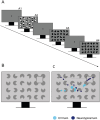Gestalt, Navon and Kanizsa illusion processing in CVI, ADHD, and dyslexia Children with Normal verbal IQ
- PMID: 39776782
- PMCID: PMC11703968
- DOI: 10.3389/fnhum.2024.1496796
Gestalt, Navon and Kanizsa illusion processing in CVI, ADHD, and dyslexia Children with Normal verbal IQ
Abstract
Introduction: Global Visual Selective Attention (VSA) is the ability to integrate multiple visual elements of a scene to achieve visual overview. This is essential for navigating crowded environments and recognizing objects or faces. Clinical pediatric research on global VSA deficits primarily focuses on autism spectrum disorder (ASD). However, in children with cerebral visual impairment (CVI) and other neurodevelopmental disorders (ADHD, dyslexia) similar deficits are reported. The aim of this study was to investigate global VSA performance in children with CVI, ADHD, dyslexia and neurotypical children by combing gaze-based measures with conventional neuropsychological tasks.
Methods: We included children aged 6-12 years with CVI (n = 20), ADHD (n = 30), dyslexia (n = 34) and neurotypical development (n = 37), all with normal verbal IQ. Eye tracking measurements were stepwise introduced within three global VSA tasks: Gestalt Closure (no eye tracking), Navon stimuli (eye tracking-based qualitative analysis) and Kanizsa Illusory Contours (KIC; eye tracking-based quantitative analysis). Verbal responses were compared with non-verbal gaze behavior.
Results: Children with CVI had significantly lower success rates on Gestalt Closure recognition, prolonged verbal response times on Navon stimuli, and decreased verbal and gaze performance on the KIC task compared to all other groups, irrespective of visual acuity. Children with ADHD and dyslexia performed similar to neurotypical children on all tasks.
Discussion: The results suggest а distinct global VSA deficit in children with CVI, which aligns with clinical observations of symptoms in daily life. Incorporating gaze-based analyses provided new information about search strategies beyond verbal answers and made the KIC task more inclusive for children with language and motor disabilities. Assessing global VSA within clinical CVI assessments could improve the differential diagnostic evaluations among children with CVI, ADHD and dyslexia, leading to more personalized treatment approaches.
Keywords: Gestalt closure; Kanizsa illusory contours; Navon; attention deficit hyperactivity disorder (ADHD); cerebral visual impairment (CVI); dyslexia; global visual selective attention.
Copyright © 2024 Hokken, Van Der Zee, Pereira, Rours, Frens, van der Steen, Pel and Kooiker.
Conflict of interest statement
The authors declare that the research was conducted in the absence of any commercial or financial relationships that could be construed as a potential conflict of interest.
Figures








Similar articles
-
Eyes on CVI: Eye movements unveil distinct visual search patterns in Cerebral Visual Impairment compared to ADHD, dyslexia, and neurotypical children.Res Dev Disabil. 2024 Aug;151:104767. doi: 10.1016/j.ridd.2024.104767. Epub 2024 Jun 10. Res Dev Disabil. 2024. PMID: 38861794
-
Visual selective attention and visual search performance in children with CVI, ADHD, and Dyslexia: a scoping review.Child Neuropsychol. 2023 Apr;29(3):357-390. doi: 10.1080/09297049.2022.2057940. Epub 2022 Apr 20. Child Neuropsychol. 2023. PMID: 35440276
-
Parent-reported problems in children with Cerebral Visual Impairment: Improving the discriminative ability from ADHD and dyslexia using screening inventories.Neuropsychol Rehabil. 2025 Jan;35(1):54-74. doi: 10.1080/09602011.2024.2328875. Epub 2024 Mar 19. Neuropsychol Rehabil. 2025. PMID: 38502713
-
VISUAL PROCESSING IN GEORGIAN CHILDREN WITH NEURODEVELOPMENTAL DISORDERS.Georgian Med News. 2018 Nov;(284):82-87. Georgian Med News. 2018. PMID: 30618395
-
Same or Different: The Overlap Between Children With Auditory Processing Disorders and Children With Other Developmental Disorders: A Systematic Review.Ear Hear. 2018 Jan/Feb;39(1):1-19. doi: 10.1097/AUD.0000000000000479. Ear Hear. 2018. PMID: 28863035 Free PMC article.
References
-
- American Psychiatric Association (2013). Diagnostic and statistical manual of mental disorders (5th ed.).
-
- Bennett C. R., Bailin E. S., Gottlieb T. K., Bauer C. M., Bex P. J., Merabet L. B. (2018). “Assessing visual search performance in ocular compared to cerebral visual impairment using a virtual reality simulation of human dynamic movement” in Proceedings of the technology, mind, and society, 1–6.
LinkOut - more resources
Full Text Sources

